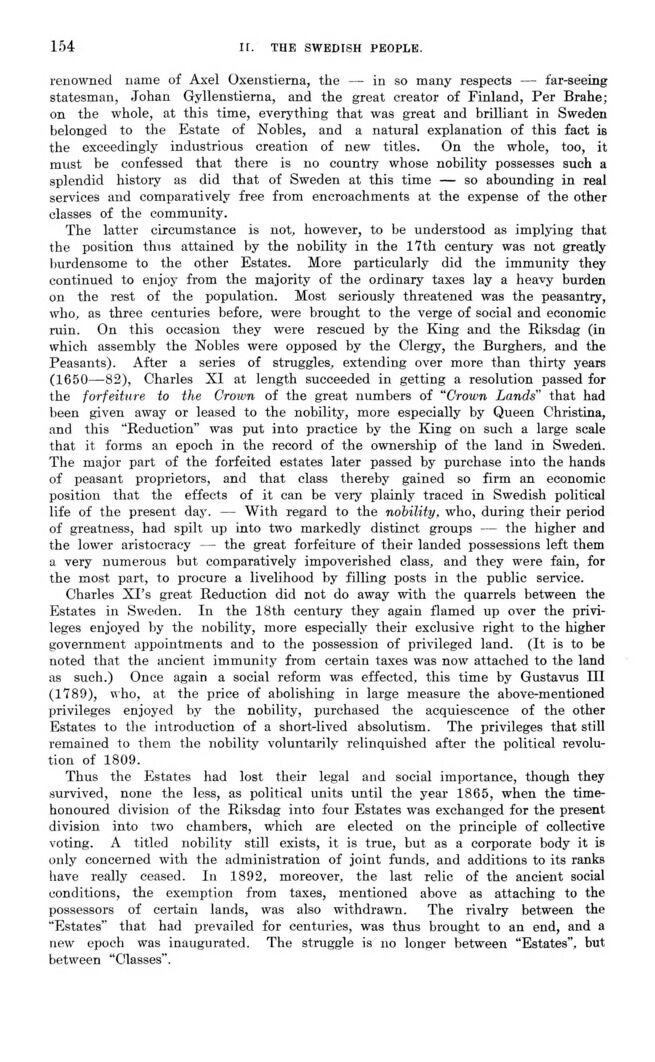
Full resolution (JPEG) - On this page / på denna sida - II. The Swedish People - 3. National Character and Social Conditions. Introd. by [G. Sundbärg] J. Asproth - Social Classes and Distinctions. By P. Fahlbeck

<< prev. page << föreg. sida << >> nästa sida >> next page >>
Below is the raw OCR text
from the above scanned image.
Do you see an error? Proofread the page now!
Här nedan syns maskintolkade texten från faksimilbilden ovan.
Ser du något fel? Korrekturläs sidan nu!
This page has never been proofread. / Denna sida har aldrig korrekturlästs.
lif)
II. THE SWEDISH PEOPLE.
renowned name of Axel Oxenstierna, the — in so many respects — far-seeing
statesman, Johan Gyllenstierna, and the great creator of Finland, Per Brahe;
on the whole, at this time, everything that was great and brilliant in Sweden
belonged to the Estate of Nobles, and a natural explanation of this fact is
the exceedingly industrious creation of new titles. On the whole, too, it
must be confessed that there is no country whose nobility possesses such a
splendid history as did that of Sweden at this time — so abounding in real
services and comparatively free from encroachments at the expense of the other
classes of the community.
The latter circumstance is not, however, to be understood as implying that
the position thus attained by the nobility in the 17 th century was not greatly
burdensome to the other Estates. More particularly did the immunity they
continued to enjoy from the majority of the ordinary taxes lay a heavy burden
on the rest of the population. Most seriously threatened was the peasantry,
who, as three centuries before, were brought to the verge of social and economic
ruin. On this occasion they were rescued by the King and the Riksdag (in
which assembly the Nobles were opposed by the Clergy, the Burghers, and the
Peasants). After a series of struggles, extending over more than thirty years
(1650—82), Charles XI at length succeeded in getting a resolution passed for
the forfeiture to the Crown of the great numbers of "Crown Lands" that had
been given away or leased to the nobility, more especially by Queen Christina,
and this "Reduction" was put into practice by the King on such a large scale
that it forms an epoch in the record of the ownership of the land in Swedeil.
The major part of the forfeited estates later passed by purchase into the hands
of peasant proprietors, and that class thereby gained so firm an economic
position that the effects of it can be very plainly traced in Swedish political
life of the present day. — With regard to the nobility, who, during their period
of greatness, had spilt up into two markedly distinct groups — the higher and
the lower aristocracy - the great forfeiture of their landed possessions left them
a very numerous but comparatively impoverished class, and they were fain, for
the most part, to procure a livelihood by filling posts in the public service.
Charles XI’s great Reduction did not do away with the quarrels between the
Estates in Sweden. In the 18th century they again flamed up over the
privileges enjoyed by the nobility, more especially their exclusive right to the higher
government appointments and to the possession of privileged land. (It is to be
noted that the ancient immunity from certain taxes was now attached to the land
as such.) Once again a social reform was effected, this time by Gustavus III
(1789), who, at the price of abolishing in large measure the above-mentioned
privileges enjoyed by the nobility, purchased the acquiescence of the other
Estates to the introduction of a short-lived absolutism. The privileges that still
remained to them the nobility voluntarily relinquished after the political
revolution of 1809.
Thus the Estates had lost their legal and social importance, though they
survived, none the less, as political units until the year 1865, when the
time-honoured division of the Riksdag into four Estates was exchanged for the present
division into two chambers, which are elected on the principle of collective
voting. A titled nobility still exists, it is true, but as a corporate body it is
only concerned with the administration of joint funds, and additions to its ranks
have really ceased. In 1892, moreover, the last relic of the ancient social
conditions, the exemption from taxes, mentioned above as attaching to the
possessors of certain lands, was also withdrawn. The rivalry between the
"Estates" that had prevailed for centuries, was thus brought to an end, and a
new epoch was inaugurated. The struggle is no longer between "Estates", but
between "Classes".
<< prev. page << föreg. sida << >> nästa sida >> next page >>